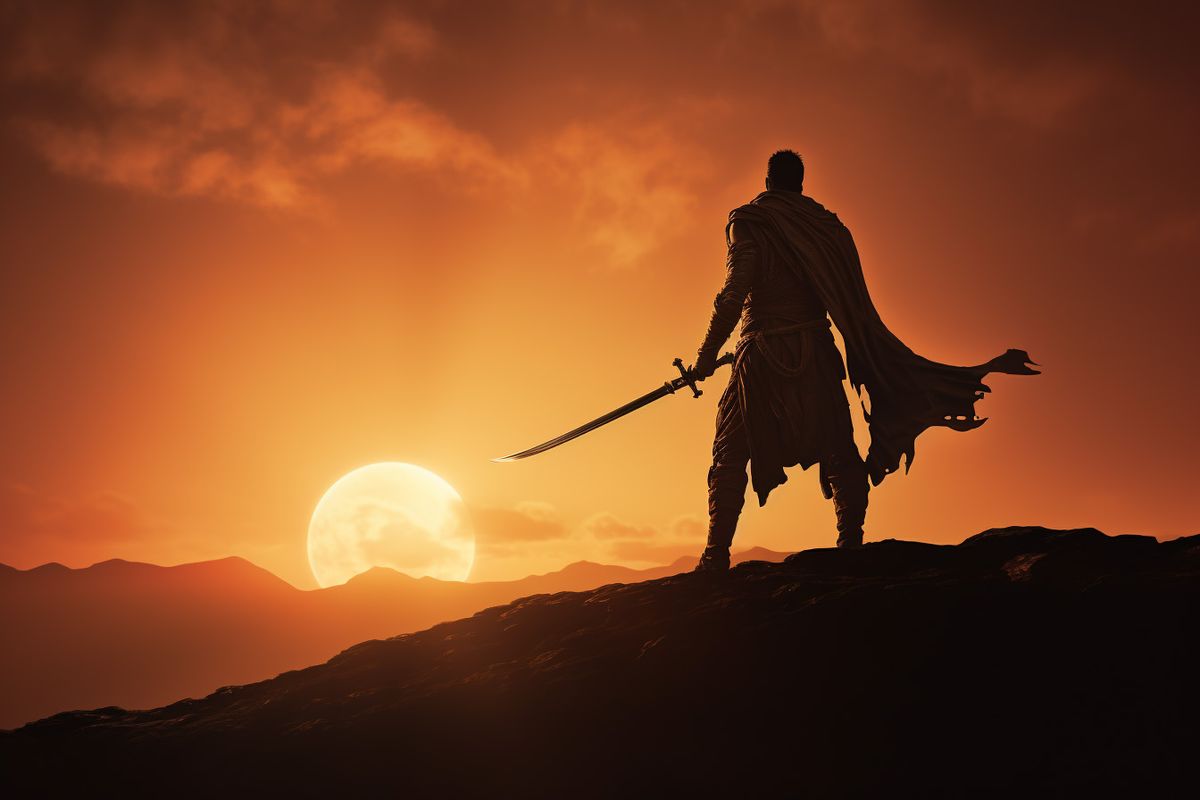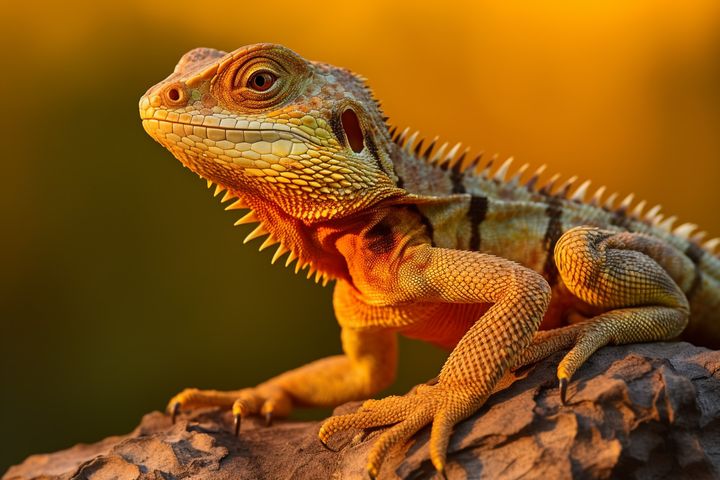Virabhadra: The Legend Behind the Warrior Pose
Discover the captivating tale of Virabhadra, the fearsome warrior born from Shiva's wrath. Learn how this profound myth inspired the Warrior Yoga poses and the timeless life lessons they offer.

Introduction: Discovering the Legend of Virabhadra
In the vast tapestry of yoga, there are not just asanas and pranayamas, but also rich narratives and myths that lend depth and context to the practice.
One such impactful tale is that of Virabhadra, a fierce warrior born from the rage of Lord Shiva. This tale provides the foundational mythology for the Warrior poses (Virabhadrasana I, II, and III) in yoga.
The Seeds of Discord: Before the Marriage of Sati and Shiva
The Divinity and Earthly Realms
In the world of Hindu mythology, the celestial beings and earthly creatures often found themselves entangled in complex relationships.
These intricate bonds formed the basis for various tales that are narrated even today, one of which is the saga leading up to the birth of Virabhadra.
The Characters: Daksha, Sati, and Shiva
To understand the origins of Virabhadra, it is crucial to acquaint ourselves with the main players in this cosmic drama.
- Daksha: The influential king Daksha was a staunch devotee of Lord Vishnu. He held a powerful position in the earthly realm and was known for his affluence and intellect.
- Sati: The princess Sati, Daksha's daughter, was no ordinary mortal. She was the incarnation of Goddess Adi Shakti, the eternal cosmic energy. Spiritual, graceful, and wise beyond her years, she was the epitome of divine femininity.
- Shiva: Lord Shiva was an ascetic god, often meditating in the mountains, adorned in rudraksha beads and ash. Unlike the affluence associated with Daksha, Shiva was removed from materialistic ambitions, embodying instead the pursuits of spirituality and knowledge.
The Ideological Divide
Daksha's lifestyle was centered around material wealth, societal standing, and worldly pleasures. He found it difficult to understand Shiva, who was focused on the pursuits of self-realization and cosmic understanding.
For Daksha, Shiva was a societal outcast who didn't fit the mold of an ideal son-in-law. This marked the beginning of a rift that would deepen over time, culminating in tragic circumstances for both families.
The Allure of the Ascetic: Sati's Attraction to Shiva
Despite her father's views, Sati was inexplicably drawn to Shiva. Perhaps it was his detached nature, his serene composure, or his profound wisdom that attracted her. On a deeper level, as an incarnation of Adi Shakti, her soul was eternally tied to Shiva's.
Ignoring societal norms and her father's disdain, she chose spiritual connection over earthly pleasures, a choice that would pave the way for the events to follow.
The Result: A Union Bound to Stir Controversy
Despite the clear ideological and lifestyle differences between their families, Sati and Shiva were spiritually united, laying the groundwork for a marital union.
This union was a cosmic event, yet it was met with bitter resentment from Daksha, causing a fracture in their familial bonds that would eventually lead to catastrophic events.
This was the world before the marriage of Sati and Shiva—a world poised on the brink of spiritual and familial conflict, setting the stage for the birth of Virabhadra.
The Yagna That Excluded Shiva
Time passed, and Daksha decided to host a grand Yagna, a ritualistic fire sacrifice. This event wasn't just a religious ceremony; it was a social gathering of monumental importance, attended by gods, goddesses, sages, and celestial beings from all realms.
A Yagna of this scale was meant to solidify Daksha's prestige and elevate his standing in the cosmic hierarchy.
A Deliberate Omission: No Invitation for Shiva
In a calculated move to slight Shiva and showcase his disapproval, Daksha purposely did not send an invitation to him. This was not merely an oversight; it was a glaring exclusion, intentional and filled with contempt. In the tightly-knit celestial community, the absence of an invitation for a family member, especially for such a significant event, was tantamount to public humiliation.
The Underlying Motive: A Clash of Ideals
Daksha's deliberate omission of Shiva was a manifestation of his deep-seated resentment towards the ascetic god. For Daksha, this was an opportunity to humiliate Shiva and make a point about his supposed 'inferiority.' The Yagna was not just a religious rite; it was now a battleground for ideological supremacy between materialism and spirituality.
Sati's Dilemma: Torn Between Family and Love
News of the Yagna reached Sati. She found herself in a difficult situation. Her father had deliberately excluded her husband, causing her both personal and public shame. The challenge for Sati was whether to attend the Yagna to honor her father and family or to stand by her husband, embodying her spiritual convictions.
The Fateful Decision: Sati's Final Choice
Ignoring Shiva's counsel to refrain from attending an event where she and her husband were clearly not welcome, Sati decided to go to the Yagna. She thought her presence could potentially mend the rift between her father and husband.
In retrospect, this decision became the catalyst for the chain of events that would lead to her tragic end and the birth of Virabhadra.
Thus, the Yagna became a crucible of unresolved tensions, heightened emotions, and clashing ideologies, setting the stage for what would become a transformative moment in Hindu mythology.
Sati's Decision: Attending the Yagna Uninvited
With a heavy heart and a sense of foreboding, Sati embarked on her journey to her father's palace where the Yagna was to be held. This was no ordinary journey; it was a trek filled with emotional and psychological undertones. As she approached the event, she had hopes that the strength of her love and commitment could overcome the hatred and misunderstanding that had marred the relationship between her father and her husband.
The Cold Reception: An Ominous Welcome
Upon her arrival, Sati was met with a cold reception. No grand welcomes or familial greetings were extended to her, signaling that her father’s grudge against Shiva extended to her as well. The atmosphere was tense, and the glances from other gods and goddesses were filled with a mix of curiosity and pity, further emphasizing her outsider status.
A Failed Attempt: Trying to Mend the Rift
In spite of the unwelcoming atmosphere, Sati tried to engage in dialogue with her father, in an attempt to mend the estranged relationship. However, Daksha remained unyielding in his stance, openly belittling Shiva in front of the gathered assembly and showing no signs of reconciliation. It became evident that Sati's courageous yet uninvited presence was not going to heal the familial divide.
Sati's Sacrifice: The Catalyst for Virabhadra's Creation
When Sati arrived at the Yagna, she was met not with the warmth and love one might expect from a family but rather with icy glares and cold shoulders. Daksha, her father, completely ignored her presence, making it abundantly clear that neither she nor her spouse, Shiva, were welcome. This was the ultimate humiliation, an affront to her and to her beloved husband.
Facing a tidal wave of embarrassment, shame, and heart-wrenching pain, Sati made an irreversible choice. Her love for Shiva and her own sense of honor outweighed everything else at that moment.
The Final Act: Sati's Ultimate Sacrifice
Before the crowd could fully grasp what she was about to do, Sati invoked a mantra, summoning her inner spiritual power, and leapt into the sacrificial flames.
It was an act of self-immolation, a final stand against the dishonor that had been meted out to her and her husband. She chose to give up her own life rather than endure the indignity and the shame that came from her own family.
As the flames consumed her physical form, Sati released her final prayers, which were not of anger or vengeance but of an undying love for Shiva. Her spirit detached from her earthly body, leaving behind a void of devastating emptiness that would soon be filled with divine fury.
A Profound Cosmic Disturbance
The moment Sati's life force left her body, ripples of her anguish and indignation spread throughout the cosmos. These were not just metaphorical tremors but palpable disruptions that unsettled the realms of gods, mortals, and everyone in between. The atmosphere turned heavy, almost as if signaling the gravity of the events that were about to unfold.
The Immediate Repercussions: A Yagna Halted
Daksha's Yagna was thrown into disarray. The rites that were supposed to bring blessings and prosperity now stood corrupted, incomplete, and void of divine grace. It was apparent that the ceremony had lost its sanctity the moment it became the platform for such an enormous tragedy.
The Terrible Realization: A Father's Guilt
Daksha, upon witnessing the terrible act, was finally struck by the gravity of his actions. His daughter, whom he had brought up with so much love and affection, had found life so unbearable due to his actions that she had chosen to end it. The weight of this realization was crushing.
The End of the Yagna: A Ceremony of Disgrace
The sacrificial fire that was supposed to be a path to divine blessings now stood as a pyre for a self-sacrifice born from unbearable humiliation and sorrow. As the flames flickered out, so did the Yagna's intended effects, leaving behind a legacy of disgrace and regret.
In these fateful moments, the stage was set for the birth of Virabhadra, the fierce warrior who would be Shiva's manifestation of wrath, born out of love, loss, and a cry for justice. It was clear that the end of this chapter was but the beginning of another—one that would change the course of divine history.
Shiva's Wrath: The Genesis of Virabhadra
When news of Sati's sacrificial act reached Shiva, the tranquility that often characterized him was replaced by an all-consuming storm of emotions.
His sorrow was immeasurable, his anguish deeper than the abyss, and his rage hotter than the fiercest flames. Each feeling seemed to compound the next, creating a tempest that no mortal, god, or demon could withstand.
In this state of divine upheaval, Shiva performed an act that was as unprecedented as it was terrifying. He pulled a lock of his matted hair and threw it forcefully onto the ground.
Virabhadra is Born
From that lock emerged Virabhadra, a being of divine power and boundless rage, manifesting Shiva's own wrath. His visage was ferocious; his body, a mountain of muscle; and his eyes, two fiery embers that could incinerate anything they beheld.
Shiva didn't need to utter a single command; Virabhadra knew instinctively what had to be done. He was the embodiment of Shiva's wrath, born to exact vengeance on those who had brought about Sati's demise and dishonored Shiva himself.
Virabhadra's Mission
The mission was crystal clear: to go to the Yagna and wreak havoc, to disrupt the ceremonial event that had been the stage for Sati's unbearable humiliation and subsequent sacrifice.
As Virabhadra set forth, followed by an army of Shiva's lesser manifestations known as the "Ganas," the skies darkened, and the Earth trembled. Nature itself seemed to recoil in anticipation of the unprecedented cataclysm that was about to unfold. The very cosmos braced for the impact of divine wrath executed by a being whose sole purpose was to serve as the instrument of Shiva's vengeance.
Virabhadra's Act: Decapitating King Daksha
Upon reaching the Yagna, Virabhadra's arrival was as dramatic as his creation. With his massive arms, he tore through the assembly like a hurricane, scattering celestial beings and sages alike.
His focus was unyielding, and his actions were unforgiving. In an act of divine retribution, he decapitated Daksha, bringing the Yagna to an abrupt and chaotic end.
Shiva's Grace: The Resurrection of Daksha
But the story didn’t end there. Shiva, often called the 'Destroyer,' is equally a god of renewal and compassion. Moved perhaps by Sati's spirit or the subsequent pleas of the other gods, Shiva decided to give Daksha a second chance.
He instructed Virabhadra to replace Daksha's severed head with that of a goat. The act was both merciful and educational: a goat's head was placed on Daksha’s shoulders, epitomizing the lesson of humility he so desperately needed.
Daksha's Transformation: From Arrogance to Devotion
Daksha was resurrected and woke up to find himself irreversibly changed, not just physically but also spiritually. Realizing the weight and consequence of his ego-driven actions, he turned his devotion towards the very deity he had so openly disdained.
His new form, with the goat's head, became a living testament to his own follies and Shiva's boundless mercy. It was his second chance at life, and this time, he was determined to live it with humility and devotion.
The Enduring Lessons: Ego, Justice, and Redemption
The tale of Daksha’s downfall, followed by his redemption, transcends time and space, offering universal lessons.
It is a narrative that dives deep into the heart of human ego, the karmic implications of our actions, and the boundless opportunities for redemption offered by divine grace.
The story speaks to the complexities of human nature, justice, and the extraordinary potential for change even in the direst circumstances.
It also illustrates the delicate balance of wrath and compassion inherent in the divine, leading us to ponder the multi-faceted nature of gods and the universe itself.
The Legacy of Virabhadra in Asanas: Understanding the Warrior Poses
In modern yoga practice, the legend of Virabhadra is honored through three key asanas: Virabhadrasana I (Warrior I), Virabhadrasana II (Warrior II), and Virabhadrasana III (Warrior III).
Each of these poses captures a different aspect of Virabhadra’s journey, and by extension, the emotional and spiritual nuances of the myth. These asanas are not just physical exercises; they are a series of movements imbued with ancient wisdom and storytelling.
Virabhadrasana I: The Birth of the Warrior
In Warrior I pose, the practitioner rises up with arms reaching toward the sky, perhaps mirroring the moment Virabhadra burst forth from the ground, ready to do Shiva's bidding.
This pose embodies the energy of creation, the first stirrings of life, and the potential for great deeds. It also serves as a reminder of the divine capabilities that lie within us, urging us to rise and face challenges head-on.
Virabhadrasana II: The Execution of Duty
In Warrior II, the yogi expands into a powerful stance, arms outstretched, and eyes focused intently over one hand. This could be seen as representing Virabhadra at the height of his mission, gaze fixed on Daksha, preparing for the inevitable act of justice.
It symbolizes the courage and focus needed to fulfill one's dharma, or purpose, even in the face of daunting challenges.
Virabhadrasana III: The Transition to Peace
Warrior III is a balancing pose, capturing the essence of transformation and the shift from chaos to peace. Just as Virabhadra’s task was completed and Shiva restored Daksha, this asana reflects the idea of returning to balance after a period of upheaval.
In life, it signifies the importance of finding equilibrium and grace, even after navigating the most challenging circumstances.
Interpreting the Virabhadrasana Series: Life Lessons in Physical Form
The sequential practice of these poses can be seen as a narrative arc, allowing yogis to explore themes of creation, execution, and transformation.
Each asana provides a meditative template for reflecting on the larger themes of the Virabhadra myth—respect for divine will, the consequences of ego, and the transformative power of compassion.
Through the physicality of these poses, one can tap into an ancestral story that explores the complexities of duty, justice, and redemption.



Comments ()